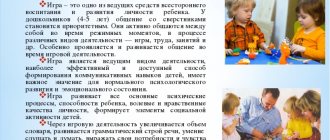Conditions for speech development
The following conditions contribute to the development of speech in a young child:
- constant friendly communication with the child, and as a result - his confidence in the adult and the desire to talk with him.
- satisfying the child’s need to communicate with peers and children of different ages.
- the linguistic culture of all adults surrounding the child! Remember that children at this age immediately understand everything you say and do.
- provide children with sufficient educational materials; books, pictures, toys, etc. Remember: the main thing is not the beauty of the decoration (although this is important), but the content of what is written, drawn, done.
- conduct special games and exercises for language development.
A necessary condition for the comprehensive development of a child is his communication with adults. The problem of communication between a child and adults is the subject of research by many psychologists: L.A. Bozhovich, L.S. Vygotsky, Ya.L. Kolomensky, T.A. Markova, L.A. Penevskaya, R.I. Zhukovskaya et al.
Adults are the custodians of the experience, knowledge, skills, and culture accumulated by humanity. This experience can only be conveyed through language. Language is “the primary means of human communication.” Young children who learn their native language master the most important form of linguistic communication—oral speech. Linguistic communication in its full form is gradually developing - understanding speech and active speech. Speaking is a very complex mental activity, which is divided into several types and forms. Speech is a special human function that can be defined as the process of communication through language. The language that is formed in children during their development goes through several stages of development and becomes a used system of means of communication and mediation of various mental processes.
The educational value of communication lies not only in the fact that it expands a person’s general worldview and contributes to the development of mental formations necessary for him to successfully carry out professional activities. The educational value of communication also lies in the fact that it is a prerequisite for the formation of a person’s general intelligence and, above all, many of his perceptual, mnemonic and mental qualities.
The child’s relationship with the adult world, which continues throughout the entire teenage stage due to the complexity and various dependencies of the mental sphere, can act as a factor in the child’s real full adaptation in his relationships with the outside world, increase his activity, independence in interpersonal contacts with other people, and can also be a source of psychological trauma to the individual, reduce his activity in subject-subject relations.
In the process of teaching and social education of a child, regardless of one or another didactic or personal development goal, there is always a system of mutual influence between an adult and a child, based on a certain level of mutual perception and relationship building, where the style of pedagogical communication plays an important role.
The individual specificity of the teacher and his uniqueness determine the stylistic features of the activity associated with specific methods of its implementation. Each teacher strives to make the most of his individual qualities that ensure success in his activities, and to overcome those qualities that hinder this success.
Features and main problems of professional communication
Communication is one of the common categories described in philosophical, sociological, psychological and pedagogical literature. Since each of these sciences examines the phenomenon of communication from different positions, the meanings attached to the concept of “communication” may be different.
Even in modern psychology there are different views on the nature of the communication process. A number of scientists/psychologists (K. Osgurd and others) consider communication as an interindividual process that comes down to the exchange of information, the transfer of something to someone (for example, knowledge, social experience, etc.). In principle, communication here refers to the process of transmitting and receiving information.
According to another approach (M. Argyle, T. Shibutani, etc.), communication comes down to understanding, exchange of information and interaction, i.e. interactions. In the light of many domestic studies, it can be argued that only the categories “communication” and “interaction” are not fully suitable for the concept of “communication”.
The process of communication accompanies our entire lives; in everyday situations, a person actively enters into communication on one issue or another. However, communication situations can be divided into informational and goal-oriented. In the first, in accordance with the name, the main motive of communication is the exchange of information. This type of interaction includes, for example, situations such as conversations at a party, among friends or relatives, that is, such cases when a person can enjoy communication.
Unlike the first option, targeted communication is usually aimed at achieving a result, solving a problem. Most often, purposeful communication is associated with the performance of professional activities. Thus, we can conclude that professional communication is always goal-oriented. Goals, in turn, are determined by the nature and situations of professional activity. It is the achievement or failure to achieve goals that evaluates the degree of professionalism of the employee, his effectiveness, and the quality of performance of his official duties.
Based on this, professional communication is understood as the process of establishing and maintaining direct or indirect contact, determined by professionally significant goals that imply responsibility for their implementation, between an employee and a person involved in his professional interests.
In turn, direct contact implies direct communication between its participants (usually verbal communication).
And indirect interaction is called indirect contact (this is communication through writing, the use of means of communication, etc.).
In professional communication we can also distinguish between interpersonal and mass contacts. Interpersonal communication is more common because it involves direct contact between two or more people. Mass communication is a series of direct contacts between unknown and unknown representatives of a certain field of professional activity.
Professional communication is multifunctional in its content and purpose. In psychological terms, the following characteristics of professional communication are distinguished:
communicative: the goal is the exchange of information between its carriers;
interactive: the goal is interaction between participants in professional contact;
perceptual: we are talking about the perception of professional information.
Professional communication is possible between people who have a common level of knowledge. In the process of professional communication, a specialist acquires highly specialized knowledge, assimilates the norms and values that have developed in the profession, and adopts the experience of others.
Direct and indirect impact
The following types of pedagogical influence are used when working with children:
- Direct pedagogical influence addressed directly to students regarding their behavior and relationships in the group. It includes the following methods of influence: instructions, explanations, rewards, punishments, and so on.
- Indirect pedagogical influence carried out through third parties. With it, the teacher does not directly issue instructions, but creates certain conditions that facilitate the children’s choice of the form of activity they desire.
For working with preschoolers, especially younger and middle-aged children, indirect pedagogical influence is most effective, since direct influence is often simply not perceived adequately due to the age of the pupils. At the same time, communication through games, reading fairy tales and fiction, and images of art achieves its goal much faster and more effectively.
The development of students is greatly influenced by the characteristics of the teacher’s pedagogical communication. If he manages to create the necessary atmosphere, win the love and trust of the pupils, training and education will be much more effective, softer and more delicate than when using authoritarian methods that suppress the child’s character and personality.
The culture of pedagogical communication of the teacher is equally important. If a teacher can cope with children solely with the help of authoritarian methods of influence, including shouting and punishment, he urgently needs to think about the reasons for what is happening and evaluate his own abilities and capabilities as a teacher. Perhaps the methods of influence he has chosen are the path of least resistance or simply the simplest way of communication, suppressing the personalities of children rather than nurturing them. By reviewing his actions, such a teacher will be able to find new, more rational and modern psychological and pedagogical foundations for communication between teachers and children.





